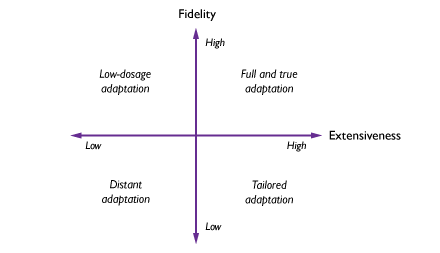Leadership Oct 1, 2011
Dimensions of Diffusion
Company to company, business practices seldom remain the same
A number of years ago,Ed Zajac was in Germany teaching a executive education course on corporate governance. While perusing the local paper one morning, the Frankfurter Allgemeine Zeitung or FAZ, he stumbled across an article on shareholder value. Zajac, who speaks and reads German fluently, was struck by something he read—not the content per se, but the language in which it was written. Tucked amidst the long German words was an English loanword, “shareholder value.”
“The fact that they wouldn’t even have a German word for it to me was quite telling,” says Zajac, a professor of management and organizations at the Kellogg School of Management. Shareholder value was relatively new to Germany, a fact that the loanword reflected. Languages often borrow new terms from other languages unmodified. In English, common loanwords may be “aloha” from Hawaiian or “avant-garde,” “faux pas,” and “omelette” from French. These words are relics of cultural exchanges, where one culture has adopted the traditions or practices of another. The nature of the adoption, though, can vary. A French omelette, for example, may be similar to an American one but quite different from an Indian interpretation.
As with cultural artifacts, business practices like shareholder value are not tethered to the place where they began. It is not uncommon to find firms from Japan to South Africa to Brazil espousing their commitment to their shareholders. Everyone appears to be speaking the same language. But just as an Indian omelette may bear little resemblance to its French inspiration, business practices are often adapted to fit the cultures that host them.
Mapping Adoption
That “shareholder value” is in the German dictionary is a sign that shareholder primacy has caught on in that country. But it doesn’t tell you how it has been adapted to fit their culture. As Zajac says, “the notion that a subgroup of individuals like shareholders have primacy among stakeholder groups wouldn’t necessarily square very well with Germans, who are brought up to believe that business interests are interwoven with community interests.” The practice was nonetheless adopted because German companies felt pressure from peer companies and investors, but not in the same way as it was among American companies. German companies “tried to cushion the blow by talking about it as a harmonious coming together of multiple objectives, whereby the pursuit of one would not lead to a diminution of the other,” Zajac says. “The idea is that we can maintain both a shareholder and a stakeholder orientation.”
Zajac’s observation led him and his then-doctoral student Peer Fiss, now an associate professor at the University of Southern California, to more fully examine the German adoption and subsequent adaptation of the shareholder value orientation. These studies led to another paper that is broader in scope. Along with co-author Shahzad Ansari, a university lecturer at the University of Cambridge, they proposed a detailed framework by which other researchers can predict and categorize how business practices change as they are adopted in different firms, societies, and cultures.
Zajac and his colleagues use two descriptors, fidelity and extensiveness, to characterize a firm’s adoption and adaptation of a business practice. Zajac borrowed the first term from his musical past, likening it to “high fidelity, which is, does it sound like the original recording? Is the reproduction really like the original or is it somehow modified?” He defines extensiveness more as “the scope with which you would adopt a practice.”
“We thought it would be interesting and useful to be able to map the idea of adaptation,” Zajac says. That map is best understood by placing the two variables each on their own axis, with fidelity running vertically and extensiveness running horizontally (Figure 1). The two dimensions capture the full range of practice variability and adaptation. Those firms that stick true to the original practice and adopt it throughout the company are said to have a full and true adaptation—they occupy the upper-right corner of the fidelity-extensiveness graph. Those that partially adopt a low-fidelity version occupy the lower-left corner.

Figure 1. Dimensions of practice variability and adaptation.
Possible Pitfalls
Classifying business practice adoption by its variability and variation does not tell the whole story, though. Firms may struggle to implement a new process, and in the course of those struggles change the process to meet specific needs. Zajac and his colleagues outline three potential hurdles a company may face when implementing a new business practice.
If a practice does not match well with the cultural beliefs of a firm’s employees, it will be adapted to meet their needs.
The first is technical fit, where a firm either has or lacks the infrastructure and know-how to adopt a practice. For example, GE was more successful in implementing Six Sigma than Motorola even though Motorola developed the strategy. This is in part because GE already had their own collection of quality management tools in place where Motorola did not.
Cultural fit is another potential pitfall. If a practice does not match well with the cultural beliefs of a firm’s employees, it will be adapted to meet their needs. In the case of cultural fit, when a business adopts a practice it affects how it is adapted. Early adopters are much freer to experiment with a practice, having little in the way of precedent to guide them. They are also more likely to push the process throughout the firm. Later users do not have the same leeway, in part due to pressure from other successful implementations. And while late adopters may implement higher-fidelity versions, they tend to do so less extensively. The final obstacle to business practice adoption is political fit. It is similar to cultural fit in the way it influences adoption, but involves office politics rather than cultural norms.
Each type of misfit exerts its own influence on how the practice is adopted and adapted. “If there’s lack of technical fit, there may be a pattern of adaptation that’s a bit different than if you have a lack of cultural fit or political fit,” Zajac remarks. The combination of fidelity, extensiveness, timing, and types of fit can all interact, which led Zajac and his colleagues to outline a number of propositions that can be tested by the many researchers working with large, multi-year data sets to assess companies and their adoption of specific business practices.
Shedding Light
Zajac and his colleagues’ framework can help dispel certain myths, such as the belief that early adopters and fast followers are both hewing to the same practice. According to the framework, that would likely prove the exception rather than the rule given the vagaries of cultural and political misfit. “What we’re saying is that the timing itself probably implies a different type of adaptation,” Zajac says. With the framework, researchers can also verify which companies are merely claiming they have adopted a practice and which have actually done so. Furthermore, people can think more scientifically about business practices by using the framework, allowing them to distinguish between low-fidelity adaptations and those different enough to be considered an entirely new practice.
“We think the applicability of our framework can be far-reaching because there are so many diffusing management practices and ideas,” Zajac says. “We will never run out of practices to study as long as there is innovation.” Beyond that, the work that he and his colleagues have done reminds management scientists and practitioners alike that culture plays an important role in the business world. “People often implicitly or explicitly assume that ‘good ideas’ are accepted by largely anonymous actors with similar preferences everywhere around the world,” he says. “But the prism with which these actors evaluate options and opportunities is shaped by their cultural and organizational backgrounds and experiences.”
Related reading on Kellogg Insight
Does Function Follow Organizational Form? Lending practices of large and small banks
Ansari, Shazad, Peer C. Fiss, and Edward Zajac. 2009. Made to Fit: How Practices Vary As They Diffuse. Academy of Management Review 35: 67-92.


